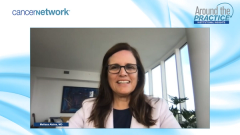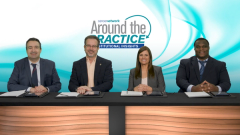
Transplant-Eligible NDMM: Overview of Available Induction Therapies
Experts from the Moffit Cancer Center share insight on induction therapy strategies and optimization for patients with transplant-eligible newly diagnosed multiple myeloma.
Episodes in this series

Transcript:
Melissa Alsina, MD: Hello, and welcome to this Cancer Nework®, Around the Practice® program, titled Advances in Multiple Myeloma, Insights from Experts at Moffitt Cancer Center [Tampa, FL]. I am Melissa Alsina, professor of medicine, and head of the myeloma section in the Bone Marrow Transplant and Cellular Immunotherapy Program at Moffitt Cancer Center. I am joined today by a panel of experts in myeloma from my program. I would like to welcome my colleagues and friends to introduce themselves.
Brandon Blue, MD: Hello, I’m Dr Brandon Blue from Moffitt Cancer Center.
Rachid Baz, MD: Hello, my name is Rachid Baz. I am from Moffitt Cancer Center as well.
Ken Shain, MD, PhD: Dr Ken Shain. I’m also 1 of the physicians at the Moffitt Cancer Center.
Melissa Alsina, MD: Welcome everyone. Thank you for joining me. Today we’re going to discuss a number of recent updates in the context of the treatment landscape of myeloma. We will review the role of traditional and emerging therapies in myeloma, and how they can be appropriately selected in clinical practice to improve patient outcomes. Let’s get started with our first topic, which would be about the evolving treatment landscape in patients that have newly diagnosed myeloma and are transplant-eligible. You know the general standard of care to treat a newly diagnosed myeloma patient would be to give induction therapy with RVd [Revlimid (lenalidomide) plus Velcade (bortezomib) and dexamethasone], followed by transplant, followed by maintenance. But several clinical trials have been done and published recently that have challenged that standard. Ken, do you mind describing some of those stories, and how you feel they’re going to change what we’re currently doing?
Ken Shain, MD, PhD: Absolutely, Melissa. There have been a number of sites, again challenging, or maybe integrating other agents into the standard of care. And I think between the IFM [NCT01191060] and now more recently the DETERMINATION [NCT01208662] study looking at really 3-drug induction therapy, transplant, maintenance vs no transplant. Really kind of, in some of our minds, we strengthen the idea of using transplant as a part of our therapy in newly diagnosed transplant- eligible individuals. With outstanding results, improved PFS [progression-free survival], even better than the IFM had in the past, where they used attenuated maintenance. But I think one of the things to think about is there are newer agents like monoclonal antibodies, and really, there are a number of studies introducing these monoclonal antibodies into induction therapy. One is the GRIFFIN study [NCT02874742], which was with daratumumab [Darzalex] plus lenalidomide, bortezomib, and dexamethasone as an induction transplant vs the standard of care, RVd transplant. Then again for drug consolidation and maintenance vs just relevant maintenance. So again, demonstrated improved outcomes can be garnered, and then again another study called the MASTER study [NCT03224507] is introducing daratumumab into a carfilzomib [Kyprolis]/Revlimid/dexamethasone induction regimen. Again, showing improved MRD [minimal residual disease] rates. So depth to response levels we haven’t achieved in the past. So these are really critical things that are really demonstrating that we can even build on and make better the current standard of care, which is 3 drugs, and evolve to a new standard of care going forward. And these are just kind of some of the key studies that are going on now that we’re learning about, changing and introducing a new standard of care.
Rachid Baz, MD: Ken, you mentioned the MASTER study was also a discontinuation study and there was interesting data presented, related to the outcomes of patients who discontinued therapy based on MRD status. Can you comment on that?
Ken Shain, MD, PhD: Yeah, absolutely. I think the MASTER study was amazing because it came around this concept of can we stop therapy, can we use minimal residual disease as a surrogate end point for stopping therapy after achieving this after multiple consolidations? And so, I think it’s really a hypothesis-generating study. It doesn’t demonstrate this as the right thing to do. What it does show is that in the right patient population there may be a question we can ask, which is can we stop therapy instead of continue maintenance therapy, which is our standard practice today? In that study, we learned that maybe standard-risk patients, and even some high-risk patients, may really benefit and maintain a long-term response. Again, still early in the study, and follow-up, but demonstrated that. Now, ultra-high risk, probably just patients with multiple high-risk features, they’re already progressing from MRD status. So maybe there’s something else we need to think about for those individuals who are not stopping therapy. But again, it’s a great study, and now we have to ask questions: Can we do this vs not doing this? And address this isn’t really practice-changing but I think it’s an outstanding hypothesis as a generating study.
Brandon Blue, MD: I think that’s important too, because now we have these studies that are actually using MRD. Before we were able to detect MRD positive or negative, we didn’t really know what to do with this. And now we have these studies basically answering those questions. Now we have positive vs negative. This is what the right way to do, or at least this is, really some information on what to do, so I think that’s really what was helpful. It’s important that when you have these newly diagnosed patients to actually check for those things so that you can follow them down the road.
Rachid Baz, MD: I completely agree with Brandon. I think the role of MRD is going to be very exciting in the future especially. But I think right now the data we have, I don’t think is enough for us to really discontinue therapy that a lot of time can be well tolerated for patients and produce excellent outcomes. I think we need more studies like the MASTER study and longer follow-up on those studies before we can safely say, “Oh we should be able to discontinue therapy for all MRD- negative patients.”
Ken Shain, MD, PhD: I think [there are] some critical things you said there, Rachid, [that] are important. So 1, even the GRIFFIN study, which was 4 drugs, transplant, consolidation vs 3 drugs. It’s phase 2, and its end point was CR [complete response] rate, so it’s not PFS even though [it] demonstrated positive PFS. There’s a larger study going to prove, or answer, that question. The same thing with MASTER. These studies are generating these hypotheses; can we do this? Now we still have to answer these questions, but I think it all rolls into our practice as we only think about taking care of our patients.
Melissa Alsina, MD: I want to touch on a few points of the data that you have discussed. No. 1, the story, you mentioned that the DETERMINATION study is very similar to the IFM story. They were just looking for induction therapy followed by transplant, vs delayed transplant, or no transplant initially. And both studies were positive in terms of PFS. There was no recurring survival I should mention. But the DETERMINATION study actually showed better results than the IFM study in terms of PFS. You touched on it, but I want to emphasize that because I think it’s important. First, tell me why you think that is, and how would that help us manage our patients post-transplant, based on that data?
Ken Shain, MD, PhD: Great points, Melissa. So first and foremost, the biggest difference again, is these are 2 different studies, and 2 different patient populations. While they’re chosen for the same purpose by the same criteria, they are still 2 different studies. We have to be a little bit careful in making true comparisons, but the reality is they were designed to be done at the same time and designed for the same patient population. The biggest difference was finite, ie time-limited maintenance therapy. In the IFM study, for 1 year, 12 months post-transplant. Whereas the DETERMINATION, which is a more western North American-based study, there was continued maintenance therapy, so there was no stopping. And so when you mentioned there was a slight improvement in PFS, really what was remarkable is both arms were better. In fact, the control arm for DETERMINATION was essentially the same as the maintenance arm in IFM, almost at 46 or 47 months. And then you added another 20-plus months, with the transplant in the transplant arm. So I think it kind of highlights at least 1 hypothesis we can make, which is really that continued maintenance makes a huge difference in outcomes. I think that’s something we’ve pressed continually. We haven’t done time-limited maintenance therapy, and for those who can tolerate it again, on a patient-to-patient basis, it may not be continued forever. I think it’s a huge thing to comment on, is that really the continued therapy is one of the things that is the low-hanging fruit of what’s different between these 2 studies, and may explain differences in the PFS. Again, the fact that even the non-transplant arm in DETERMINATION was as good at least, this had the same PFS, plus or minus a few months as the transplant arm did in IFM. So these are just things I was trying to comment on.
Melissa Alsina, MD: Right, and the other point, I mean we are going to discuss this more later but MRD. What is the role of MRD, and how do we adjust our therapy? In the DETERMINATION study, they look at the patients that have achieved MRD before a transplant, and they were MRD negative, and those patients that were MRD negative did the same, with transplant or without transplant. Obviously, that was not the primary objective of the study. However, it gave us key insight that MRD is important. And perhaps the studies are adjusting the therapy data based on if a patient is MRD mature, then there will be, maybe in the future, right? And we would not treat all the patients the same, but more so adapt the therapy according to their response.
Transcript edited for clarity.
Newsletter
Stay up to date on recent advances in the multidisciplinary approach to cancer.






































































































